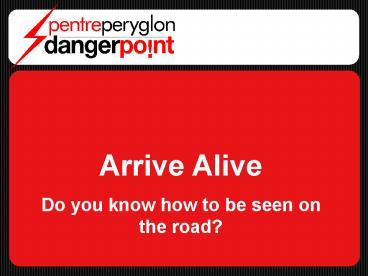Arrive Alive - PowerPoint PPT Presentation
1 / 29
Title:
Arrive Alive
Description:
Stay safe on your bike. Always wear a cycle helmet. Make sure ... Stay safe on your bike ... I can ride my bike on the pavement. True. False. Fact or Myth? ... – PowerPoint PPT presentation
Number of Views:152
Avg rating:3.0/5.0
Title: Arrive Alive
1
Arrive Alive Do you know how to be seen on the
road?
2
Can you cross the road safely?
What rules for crossing the road safely do you
know? Stop Look Listen Think Find the safest
route Find the safest crossing place Be
Seen Judge speed and distance of approaching
vehicles Find the safe gaps Think for yourself
3
Did you know?
Did you know that each year over 140 children
are killed and 4,200 seriously injured walking or
cycling on British roads?
4
Did you know?
More than twice as many boys as girls are
killed or seriously injured in pedestrian and
cycle accidents.
5
Find the safest route
Think about your journey to school. Do you
walk, travel by bus, car or taxi? Do you know
what rules apply to you?
6
Did you know?
Traffic is the biggest single killer of 12-16
year- olds in Britain.
7
Find the safest crossing place
Always cross at a crossing or with a crossing
patrol.
8
Be seen
You can be seen at night if you wear Reflective
Clothing. The light is reflected off your
clothes and drivers can see you easily. It is
also important to be seen in the day. Fluorescent
Clothing will stand out during the day.
9
Did you know?
1 in 4 young people cross at traffic lights
without waiting for the green man sign.
10
Judge speed and distance of approaching vehicles
At what speed can vehicles drive on the roads
where you walk? In most built up areas
vehicles can travel at up to 30 mph. At this
speed the total stopping distance in good
conditions would be 6 car lengths. How would a
change in weather alter the stopping distance of
a car travelling at 30mph? How would an increase
in speed to 40mph affect the total stopping
distance?
11
Stopping distances
Thinking Distance Car Lengths 1.5 2.5 3 3.5 4.5 5
Speed 20 mph 30 mph 40 mph 50 mph 60 mph 70 mph
Braking Distance Car Lengths 1.5 3.5 6 9.5 13.5 19
Total Stopping Distance Car Lengths 3 6 9 13 18 24
Figures given are for cars travelling in good
conditions. Figures taken from
www.thinkroadsafety.gov.uk
12
Identify Safe Gaps
Use your knowledge of speed and stopping
distances to identify safe gaps in approaching
traffic. Dont start to cross unless you are
sure that it is clear both ways. Look right.
Look left. Look right again.
13
Did you know?
1 in 10 young people involved in a road traffic
accident said they were not looking or paying
attention.
14
Think for Yourself
Always be responsible for yourself when
crossing the road. DONT JUST FOLLOW, THINK
FOR YOURSELF!
15
Did you know?
1 in 4 young people chat on a mobile and 1 in 5
text on a mobile whilst crossing the road.
16
Stay safe on your bike
Always wear a cycle helmet. Make sure other
road users can see you. Wear fluorescent
materials in the day and reflective materials at
night.
17
Stay safe on your bike
You must have a white front light, a red back
light and a red reflector at the back. Use
your eyes and ears all the time. You must obey
traffic lights, road signs, police officers and
school crossing patrols. What other rules can
you think of for cyclists?
18
Can you sort the facts from the myths?
Read the following statements, click on True or
False to find out whether you are right.
19
Fact or Myth?
The speed check vans are only a way for the
police to make more money! True False
20
Fact or Myth?
I can ride my bike on the pavement. True
False
21
Fact or Myth?
The speed check vans are in place to reduce
casualties on the roads. In North Wales, between
Jan 1998 and Dec 2001, there were 2,333 children
killed or injured. True False
22
Fact or Myth?
It is against the law to cycle at night without
a white front light, a red back light and a red
reflector at the back. True False
23
Fact or Myth?
When you are cycling you dont need to stop at
traffic lights or follow road signs.
True False
24
Fact or Myth?
When travelling in the front or rear of a car
appropriate child restraint must be worn if
available. If not, an adult seat belt must be
worn. True False
25
Congratulations!
You have successfully sorted the facts from the
myths.
26
What do you do?
Think carefully about the following questions
and think about whether you are road safe.
27
DO you
Take notice of road signs? Use the Green
Cross Code? Cross at a safe crossing
place? Wear bright clothes so that other road
users can see you? Wear a helmet when
cycling? Wear a seatbelt? Get out of cars on
the pavement side? Plan your route to avoid
hazards? Walk on the right side - into
approaching traffic, so as to be seen?
28
Further Information
www.think.dft.gov.uk www.hedgehogs.gov.uk www.road
code.co.uk www.bmweducation.co.uk www.rospa.org.uk
www.roscow.org.uk
29
Keep safe on the roads
Stop! Think! Act!































